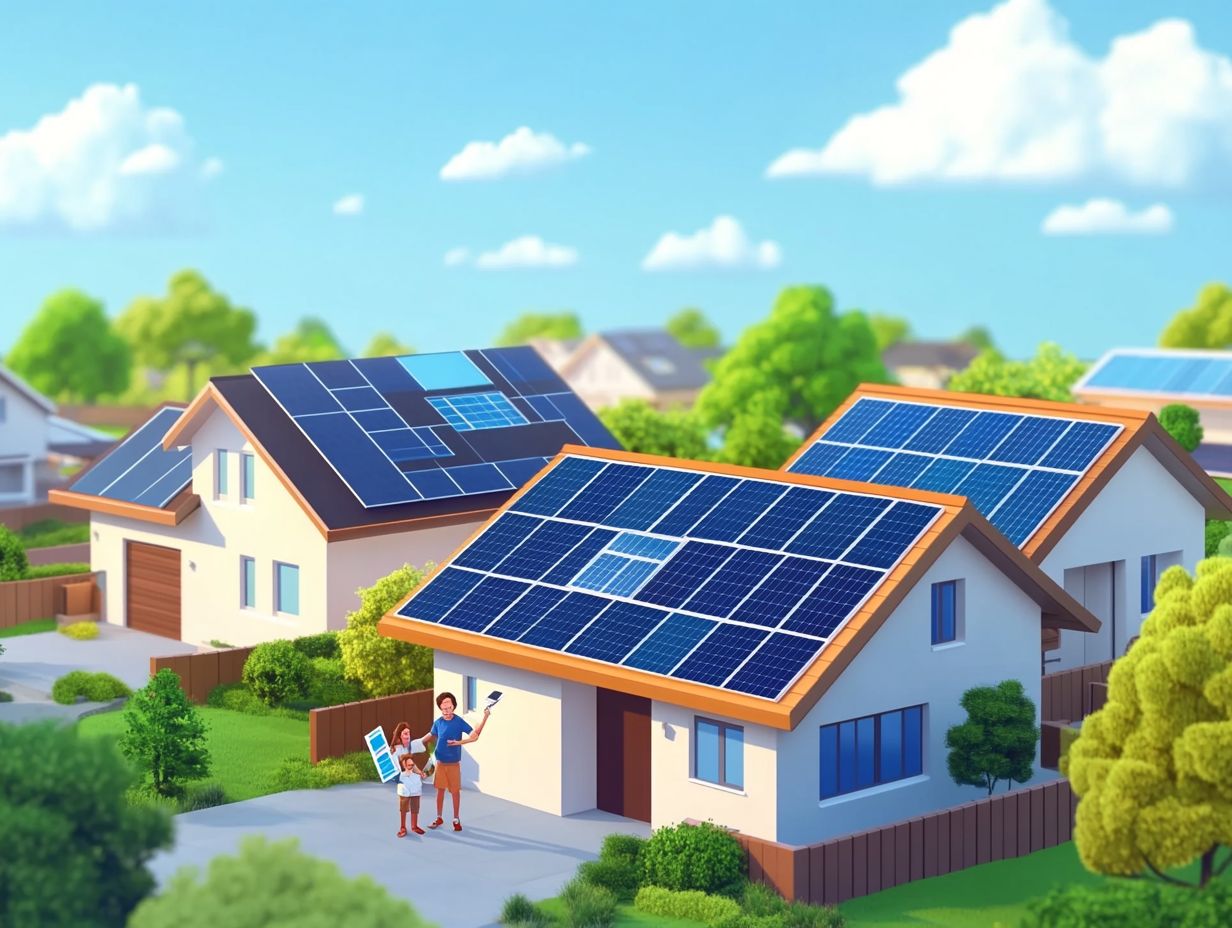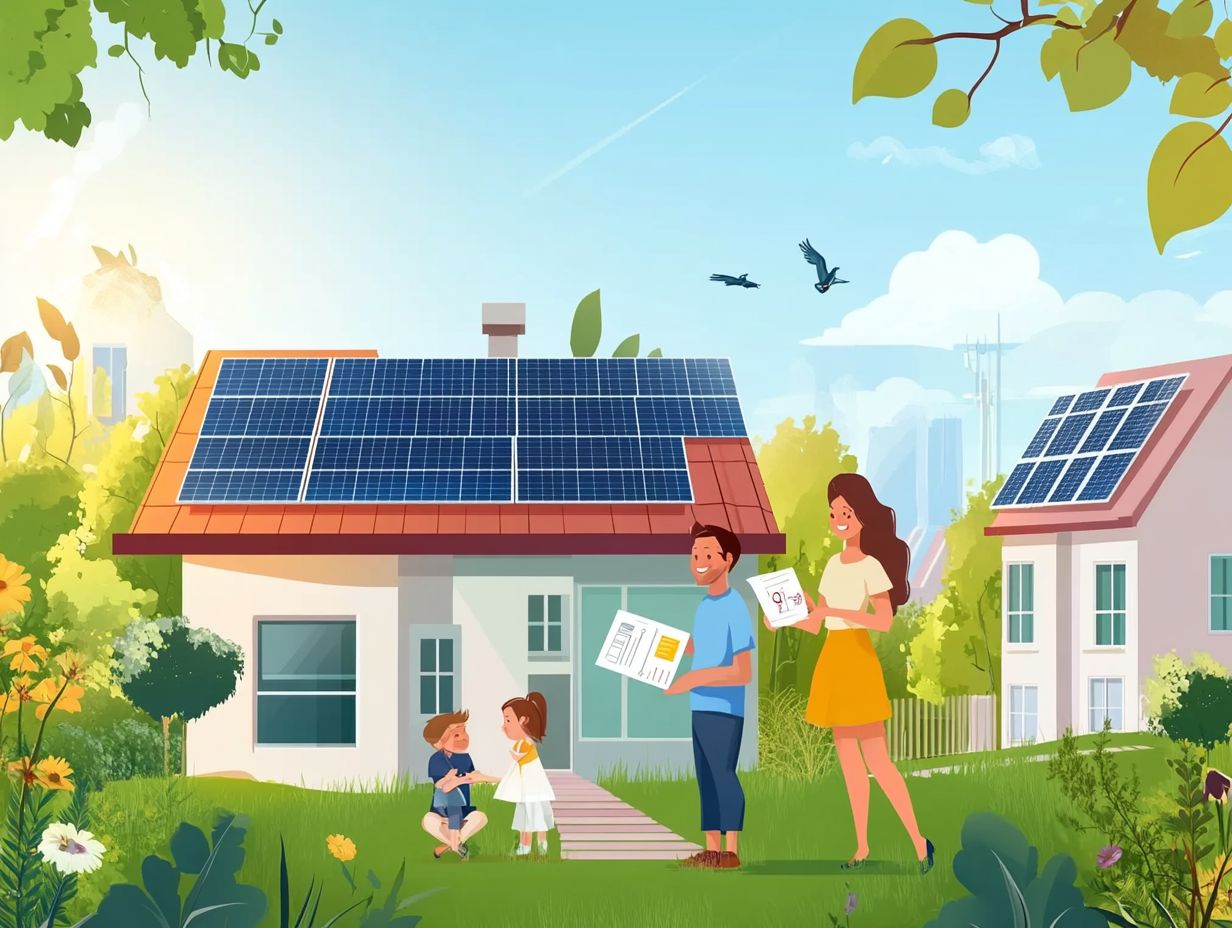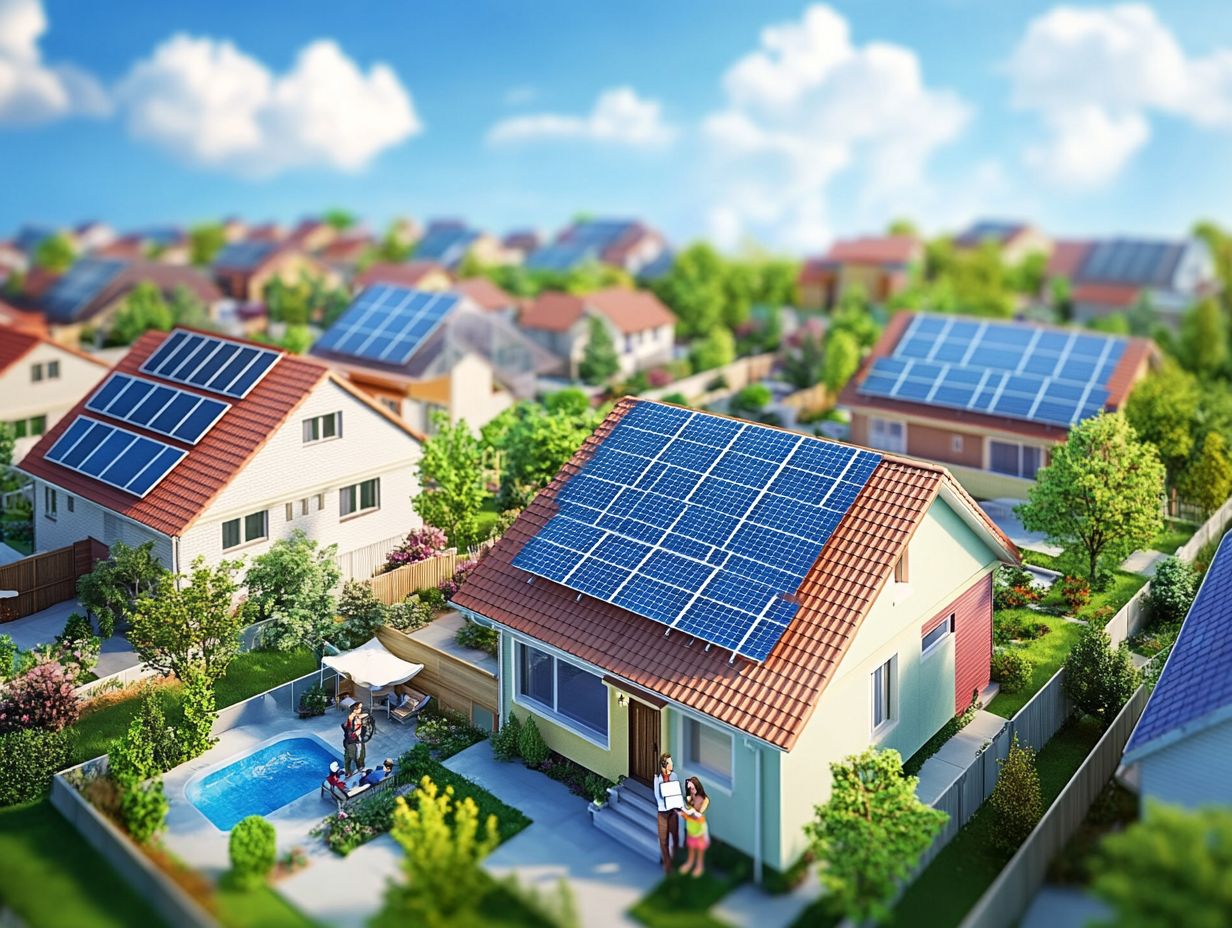Contents
- 1 Understanding Solar Financial Savings
- 2 Real-life Case Studies
- 3 Significant Cost Savings from Solar Energy
- 4 The Environmental Benefits of Solar Energy
- 5 Key Factors Influencing Solar Financial Savings
- 6 Frequently Asked Questions
- 6.1 What is a case study for solar financial savings?
- 6.2 Benefits of Solar Financial Savings Case Studies
- 6.3 Variation of Results in Solar Financial Savings Case Studies
- 6.4 Common Trends in Solar Financial Savings Case Studies
- 6.5 Credibility of Solar Financial Savings Case Studies
- 6.6 Using Solar Financial Savings Case Studies for Decision-Making
Understanding Solar Financial Savings

Solar financial savings are all about the significant drop in your energy bills and overall costs when you invest in solar energy systems, like photovoltaic systems and solar panels, as well as understanding the payback period and long-term savings.
By tapping into the sun’s power, you can enjoy some serious financial perks while also doing your part for a more sustainable energy future and contributing to the renewable resources movement. This means less reliance on traditional energy sources and a positive impact on climate change.
It’s a win-win!
Real-life Case Studies
Exploring real-life case studies gives you some fantastic insights into how effective solar energy systems can be, the financial savings they can rack up over time, and the positive economic impact on communities.
You’ll see how different homeowners and businesses have successfully jumped on the solar bandwagon and reaped the benefits of renewable energy technologies.
These examples act as proof for anyone considering solar energy, showcasing the potential for savings, the overall boost to property value, energy independence, and environmental impact.
Examples of Successful Solar Installations
You can find successful solar installations in all sorts of sectors, which really highlights how versatile photovoltaic systems are when it comes to generating energy, achieving cost-effectiveness, and saving money.
Whether you’re looking at residential solar systems that enable homeowners or commercial solar solutions that help businesses cut down on operational costs, these installations clearly show the amazing benefits of embracing solar energy technologies and the importance of performing a comprehensive cost-benefit analysis.
For instance, a typical residential installation might have rooftop panels that generate enough energy to cover up to 100% of your household’s energy consumption, which means you could see some significant monthly savings on your utility bills and gain energy security.
On the commercial side, big players like Walmart and Apple have made hefty investments in solar energy, with projects that churn out massive amounts of clean energy, leading to millions of dollars saved each year and highlighting excellent investment returns.
These initiatives not only help lower operational costs but also send a powerful message about sustainability. They align with the growing trends in the solar market, which are all about promoting community solar installations, making green energy more accessible, encouraging a shared sense of environmental responsibility, and understanding the asset depreciation benefits.
Barbose, G., Darghouth, N., Millstein, D., Spears, M., Wiser, R., Buckley, M., Widiss, R., & Grue, N. (2016). Tracking the Sun: Installed Price Trends for Distributed Photovoltaic Systems in the United States. Lawrence Berkeley National Laboratory. Link
Significant Cost Savings from Solar Energy
The cost savings from solar energy can be pretty impressive. By using solar panels and renewable technologies to generate your own electricity, you can really cut down on those energy bills and improve your financial projections.
Plus, you can boost those savings even more with various solar incentives, tax credits, and financing options that make investing in solar even more worthwhile, enhancing your overall return on investment.
Reduction in Energy Bills

By switching to solar energy, you can really cut down on your energy bills, which adds up to some serious savings over time—especially if you live in an area with high utility rates and are looking for effective energy alternatives.
Using grid-tied systems means you can use energy more efficiently, and any excess energy you produce can be fed back into the grid, boosting your financial benefits even more through net metering.
Of course, how much you save can vary based on things like local electricity rates, your energy consumption habits, and specific savings potential. For example, if you live in states with higher average utility costs, like California or New York, you might see some pretty significant reductions in your monthly bills compared to folks in areas with lower rates.
If you tend to use more energy during peak sunlight hours, you’re really in luck because solar systems generate the most power then, maximizing your energy production. So, going solar isn’t just about being eco-friendly; it also puts you in the driver’s seat when it comes to your expenses and lets you take advantage of the financial incentives tied to renewable energy.
Solar Incentives and Tax Credits
Solar incentives and tax credits are key players in making solar energy systems more accessible and financially beneficial for you, whether you’re a homeowner or a business owner. They help offset installation costs, improve solar return, and encourage the switch to renewable energy.
There are also various financing programs, funding options, and local incentives that can make solar even more appealing, offering options that fit your unique financial situation and enhance investment analysis.
These incentives come in various forms, including federal and state tax credits that can significantly lower the overall cost of installing solar panels. Plus, there are local grants, solar financing options, and subsidy programs that encourage eco-friendly practices.
By taking advantage of this financial support, you can slash your initial expenses, leading to a much better return on your investment over time, and improve your financial projections.
These incentives not only help you make the switch to solar energy, but they also promote a wider acceptance of renewable technologies in your community, contributing to a more sustainable future for everyone, while providing consumer insights on solar adoption.
The Environmental Benefits of Solar Energy
The environmental benefits of solar energy are pretty impressive, including significant environmental savings and climate impact mitigation. When you transition to renewable energy sources like solar, you’re making a big difference in reducing your carbon footprint and fighting against climate change.
By investing in and using solar technologies, you can embrace sustainability, improve energy efficiency, and support the move toward a cleaner, greener energy future.
Reducing Carbon Footprint
Reducing your carbon footprint by adopting solar energy isn’t just a nod to sustainability; it’s also a way to gain energy independence, boost energy security, and cut down on fossil fuel reliance. As more people and businesses jump on the solar bandwagon, the collective impact on our environment becomes pretty significant, especially as regulations continue to evolve to tackle climate change.
This move toward solar technologies does more than just generate clean electricity; it gives you a sense of control over your energy sources and helps in mitigating energy policy challenges. By harnessing sunlight, you can reduce your dependence on fluctuating energy prices and boost your resilience against unexpected energy shocks, ensuring better energy strategy implementation.
Plus, supportive regulatory frameworks, like tax incentives, renewable energy mandates, and power purchase agreements, are key in encouraging this shift. They make it easier for you to transition to solar by providing financial relief, simplifying the process, and enhancing project viability, making solar solutions more accessible than ever.
In the end, the beauty of solar energy lies in its ability to help you reduce carbon emissions while achieving energy self-sufficiency, making it an essential piece of the puzzle for a sustainable future and a key element in solar trends.
Impact on Local Communities

The impact of solar energy on your local community is pretty impressive, offering significant economic impact and job creation. It brings economic benefits through job creation, energy resilience, and better access to renewable energy sources like community solar projects.
These initiatives not only help you save on energy costs but also give you a chance to actively participate in the energy transition and improve financial literacy.
Start your solar journey today!
Community solar projects are especially beneficial because they allow you to engage in sustainable energy practices without needing your own solar panels, and benefit from collective energy savings calculations. These programs often draw in investments that stimulate the local economy, create jobs in installation and maintenance, provide educational opportunities in renewable energy technologies, and highlight live data on solar adoption.
By reducing reliance on fossil fuels and lessening the impacts of energy price fluctuations, these initiatives contribute to energy resilience and bolster savings calculator accuracy.
Plus, when you and your neighbors get involved in energy production, it not only strengthens economic stability but also fosters a sense of collective enablement, aligning with industry benchmarks and market analysis. This builds stronger community ties and a shared commitment to sustainability.
Key Factors Influencing Solar Financial Savings
Several factors play a role in your solar financial savings, like your geographical location, climate conditions, system size, the overall efficiency of the solar technologies you’re using, and the effectiveness of your energy audit.
By understanding these elements, you can optimize your solar investments and make sure you’re getting the most financial benefits, energy production, and superior performance metrics from your system.
Impact of Location and Climate on Solar Energy Potential
The location and climate of your property play a huge role in its solar energy potential. They determine how much energy your solar system can produce and how efficient it will be overall. If you’re in a sunnier region, you’re likely to see higher energy production and better system performance. On the flip side, if you’re in a cloudier area, you might want to look into advanced solar technologies or efficiency upgrades to really maximize your savings.
But it’s not just about how much sunlight you get; geographical factors like terrain and elevation can also affect how well your solar panels work. For example, if you live in a place that gets a lot of snow, you’ll need specialized solar installations that can handle those harsh conditions and ensure continuity of cash flow analysis. And don’t forget about coastal locations, which might have to deal with salt corrosion and may benefit from tailored risk assessment.
That’s why doing a thorough site assessment and financial analysis is so important. It gives you a better understanding of local weather patterns, shading from nearby structures, the best spots for placing your panels, and enhances your investment returns analysis.
By keeping these factors in mind, you can make smart decisions about which solar technologies, such as photovoltaic systems and solar panels, will work best for your specific environment, ultimately boosting your energy output and getting a better return on your investment with the help of renewable energy sources.
System Size and Efficiency
The size and efficiency of your solar energy system are crucial factors that directly affect your long-term financial savings and performance. Typically, larger photovoltaic systems deliver higher energy production and greater savings potential, contributing significantly to operational savings and long-term savings.
By understanding how these elements work together, you can choose the right size and type of system to meet your energy needs, thus enhancing energy efficiency and ensuring cost-effectiveness through strategic solar investments.
Besides size and efficiency, keeping an eye on performance metrics is key to making sure your system runs at its best. Regularly tracking your energy production, financial savings, and energy consumption allows you to spot any discrepancies or inefficiencies that might pop up over time.
This kind of monitoring helps you make informed adjustments or repairs, ultimately maximizing your energy output and contributing towards greater energy independence and environmental savings.
When you’re thinking about a solar installation, it’s important to analyze your individual energy consumption patterns since these will determine the right system capacity for you. By tailoring the system to fit your specific usage habits, you not only boost performance but also ensure that your investment gives you the best possible returns, utilizing tools such as a savings calculator and cost-benefit analysis.
Frequently Asked Questions

What is a case study for solar financial savings?
A case study for solar financial savings is a detailed analysis of a real-life example where solar energy was installed and resulted in significant cost savings for the individual or organization. It typically includes information on the initial investment, installation costs, energy production, and financial returns over a specific period of time, often influenced by government incentives and tax credits.
Benefits of Solar Financial Savings Case Studies
Reading case studies of solar financial savings can provide valuable insights and information for those considering investing in solar energy. They can help you understand the potential financial benefits and risks involved, as well as provide examples of successful installations, solar financing models, and strategies for maximizing savings.
Variation of Results in Solar Financial Savings Case Studies
Yes, the results of case studies of solar financial savings can vary depending on a variety of factors such as location, system size, energy consumption, financing options, and the chosen solar financing model. It’s important to carefully review the details of each case study to determine if it is relevant to your specific situation.
Common Trends in Solar Financial Savings Case Studies
Some common trends found in case studies of solar financial savings include a decrease in energy costs, an increase in property value, and a positive return on investment within a certain timeframe. Additionally, many case studies show a decrease in carbon emissions and an overall positive impact on the environment, highlighting the sustainability and economic impact of renewable resources.
Credibility of Solar Financial Savings Case Studies
Yes, case studies of solar financial savings are typically credible as they are based on real-life examples and often provide data and metrics to support their findings. However, it’s important to carefully review the source and methodology of the case study to ensure its credibility, using financial analysis and risk assessment techniques.
Using Solar Financial Savings Case Studies for Decision-Making
Absolutely. Case studies of solar financial savings can be a valuable tool for those considering investing in solar energy. They can provide valuable insights, information, and data to help inform decision-making and determine if solar is a viable option for your specific situation, taking into account factors like project viability, solar adoption, and power purchase agreements.

